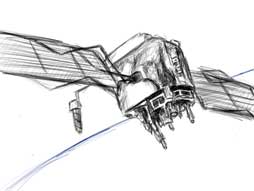By John Mayfield/reporter

An uncontrollable U.S. satellite that was set to collide with Earth’s atmosphere within a few weeks will now be shot down by order of the president.
It is believed to be a military spy satellite, and it is unclear as to the danger it could pose if it were allowed to re-enter the Earth’s atmosphere.
The errant satellite is now officially known as USA 193.
The satellite was launched in December 2006. Shortly after reaching orbit, the satellite’s power failed, and it has been uncontrollable.
The USA 193 satellite marked the first and most publicized launch by the United Launch Alliance, a joint venture between Boeing and Lockheed Martin.
The National Reconnaissance Office, a branch of the Department of Defense jointly run by the CIA, commissioned the launch. Because of the secretive nature of the satellite, the payload was referred to as NRO L-21.
While government officials are keeping quiet on the specifics of the satellite, amateur astronomers who have caught a glimpse of it estimate it to be roughly the size of a small bus and likely weighing more than one ton.
Some amateur satellite watchers believe the satellite is falling at a rate of 1,640 feet per day while Pentagon officials believe the correct estimate to be closer to five miles per day.
Ray Benge, associate professor of astronomy on NE Campus, believes USA 193 would re-enter the Earth’s atmosphere within two weeks to a month.
The exact location of the satellite’s crash would be unknown until one to two hours before its re-entry.
Pentagon spokesman Bryan Whitman said at a recent press conference that more than 17,000 man-made objects have re-entered the Earth’s atmosphere over the past 50 years.
Concerning the USA 193, Whitman said, “We are aware of it, and we are monitoring it.”
The possibility of the satellite hitting a land mass is highly unlikely, but because of the potential danger of the fuel, the decision was made to shoot it down.
Gordon Johndroe, White House national security council spokesman, said, “Given that 75 percent of the earth is covered in water … the likely percentage of this satellite or any debris falling into a populated area is very small.”
The satellite, never having reached operational status, has remained in a low orbit for the past year. Because of its low orbit, a manned salvage mission would be too risky to undertake.
Last year, the Chinese drew worldwide criticism for blowing up one of its aging weather satellites with a ground-to-air missile.
While the Chinese action was successful, it created nearly 1,000 pieces of debris, nearly doubling the known amount of orbiting man-made trash. The Chinese weather satellite was less than half the size of the falling U.S. satellite.
The USA 193’s destruction will likely create a much larger debris cloud.
The high speeds of orbiting material mean that even the smallest object could disable a satellite or jeopardize the lives of astronauts.
The Pentagon maintained until last week that shooting down the satellite would be an absolute last resort.
Some people have a small concern that if USA 193 does manage to survive re-entry, it could pose a health threat because of the chemicals it is known to carry.
Having never become operational, USA 193 still carries a full load, or 1,000 pounds, of hydrazine fuel, which is highly toxic and unstable.
The other concern is that the satellite is believed to have been equipped with solar panels, which are coated in beryllium, a Category 1 carcinogen.
It is unlikely the solar panels ever deployed, and because of their delicate nature, “there is almost no chance of the solar panels coming back intact,” Benge said.
Naval anti-ballistic missiles likely will shoot down the USA 193 by the end of the week. The explosion of the fuel tank could result in some debris being scattered over a long distance.
Benge said, “If you find a piece, don’t go lick it.”
